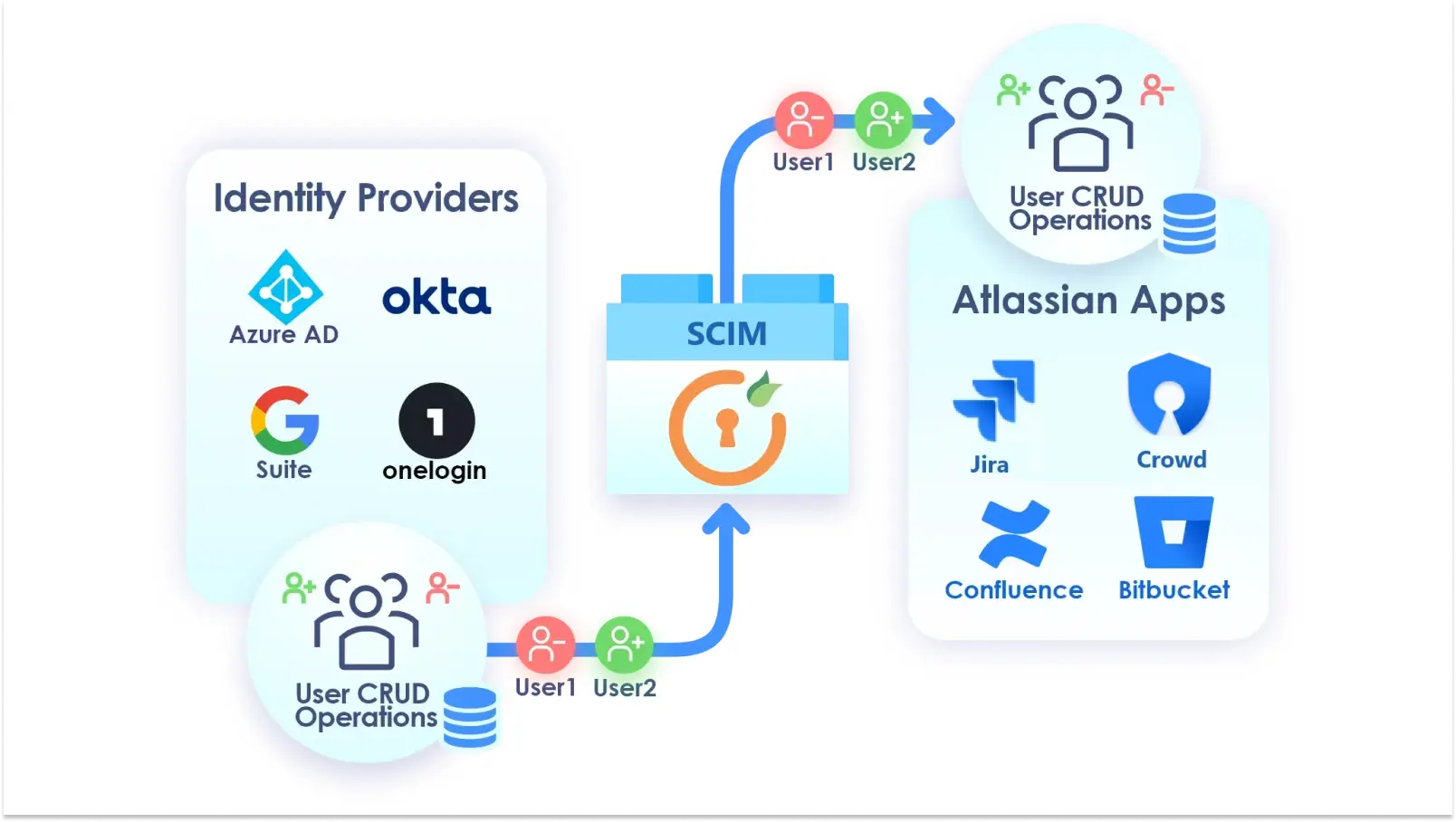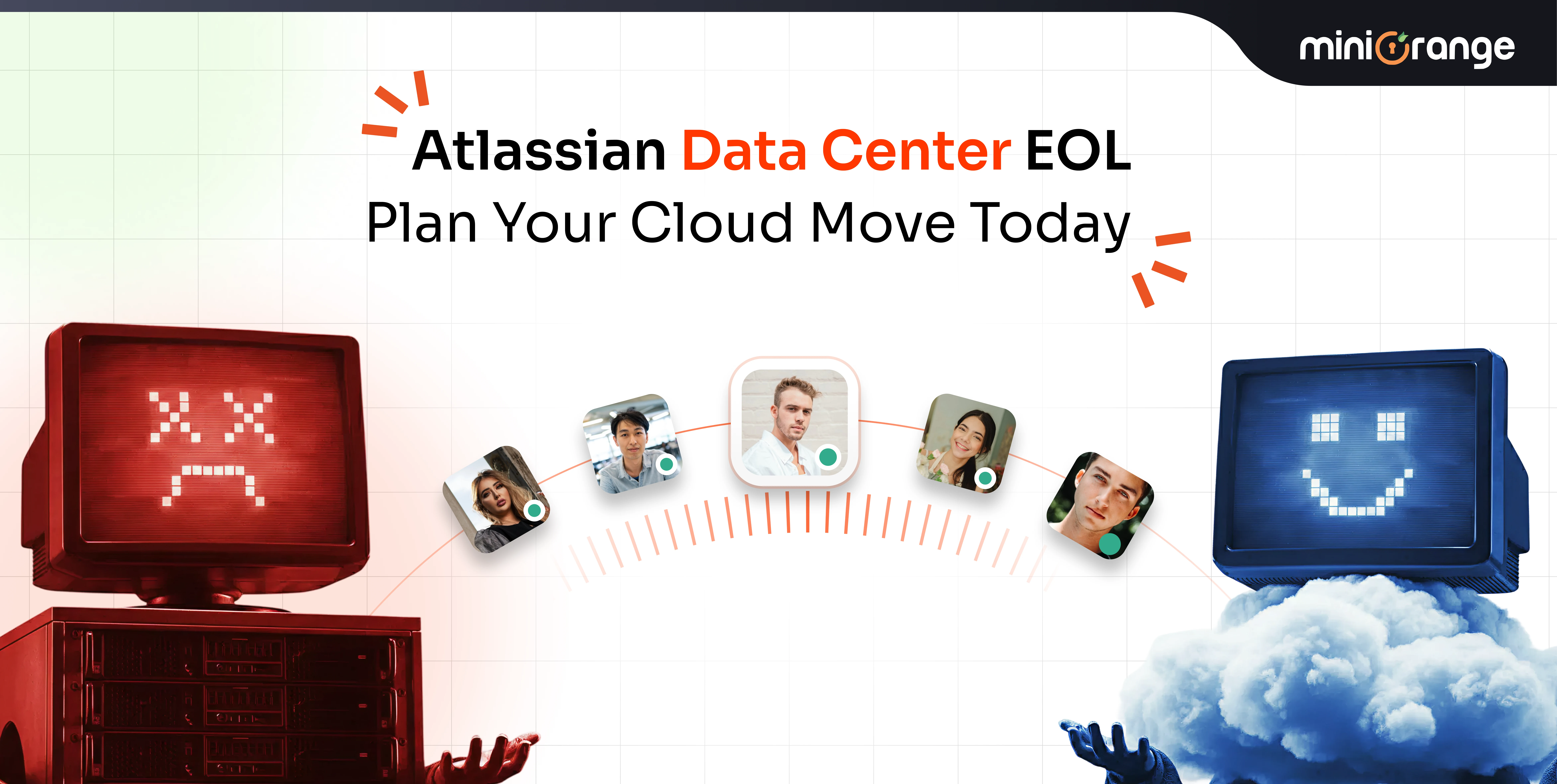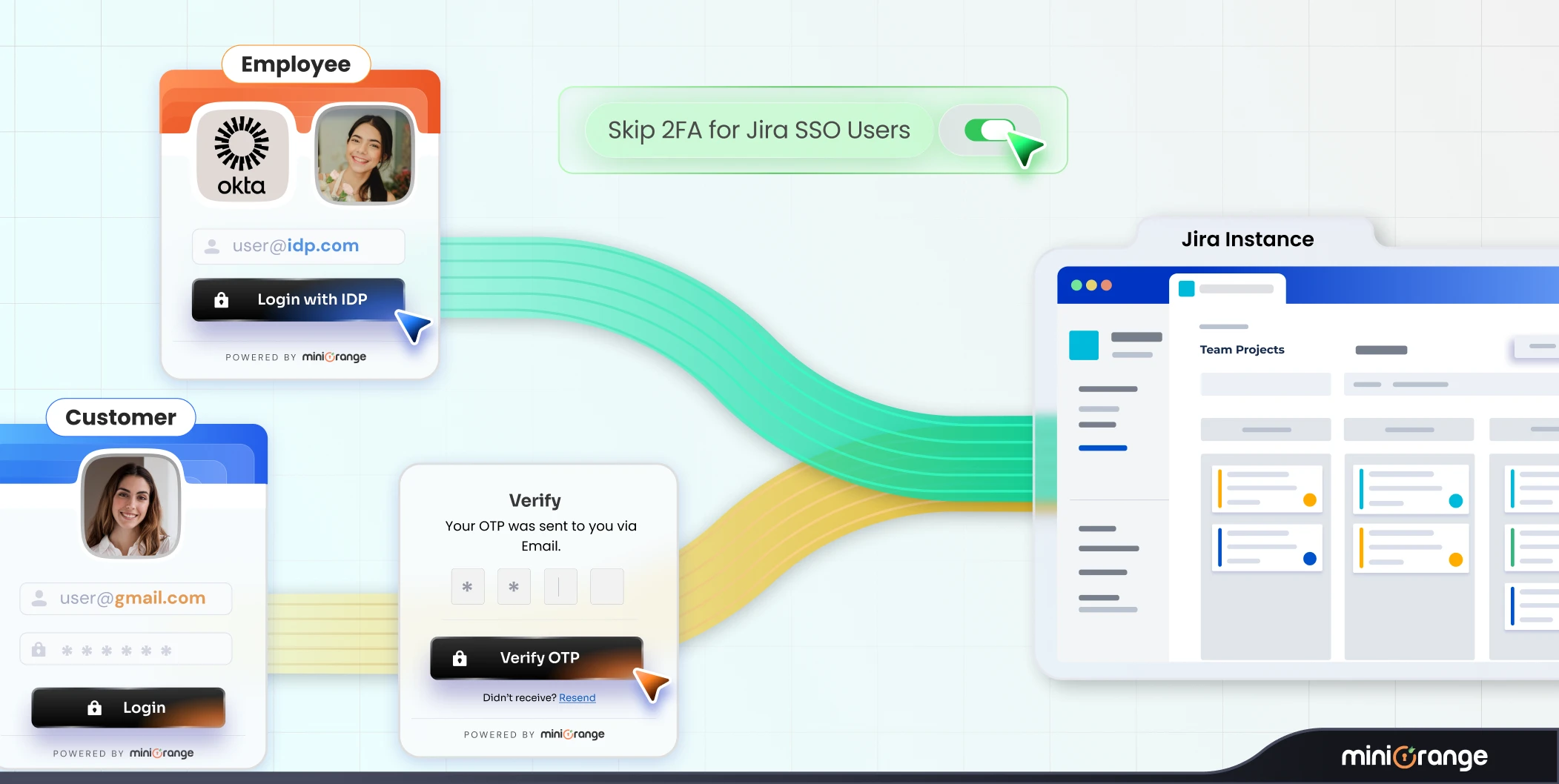Automate User Provisioning in Atlassian apps with miniOrange User Sync
Managing user access across multiple Atlassian apps can be a daunting task, especially as your organization scales. Studies show that around 30% of user licenses are unused due to manual deactivation delays, leading to increased costs and security risks. Automating user provisioning can save time, reduce errors, and help manage licenses more efficiently.
One of the most effective ways to streamline user management in Atlassian apps is by leveraging user sync with miniOrange’s SCIM Provisioning, User Sync & Group Sync. This approach not only automates user provisioning but also ensures that users have the correct permissions at all times.
What is SCIM Provisioning?
SCIM (System for Cross-domain Identity Management) is an open standard protocol that automates user provisioning and deprovisioning across cloud applications. It enables seamless synchronization of user identities and attributes between identity providers (IdPs) and service providers.
Importance of SCIM in User Management
Managing user identities manually across multiple cloud services can be error-prone and time-consuming. As organizations grow and adopt more SaaS applications, the complexity of user management increases. SCIM simplifies this process by automating the creation, update, and removal of user accounts, improving efficiency.
Why SCIM Matters:
- Automates user lifecycle management.
- Reduces manual errors and inconsistencies.
- Ensures real-time updates to user access.
- Reduces IT workload, enabling focus on strategic tasks.
How SCIM Works in Practice
SCIM operates by sending HTTPs requests to the connected applications whenever there is a change in the identity provider (IdP), such as the creation, update, or deactivation of a user account. This real-time synchronization ensures that user data and access rights are kept accurate without manual updation.
Step-by-Step Process:
- User Event Trigger: An event occurs in the IdP, such as adding, updating, or deactivating a user.
- SCIM API Call: The SCIM protocol sends a HTTPs request to the connected application.
- Data Sync: The application updates the user data, role, or permission based on the received data and sends an unique identifier to the IdP.
- Confirmation: The system verifies the update, ensuring that changes are accurately reflected.
You can also configure SCIM for Atlassian Data Center using our step-by-step guide.
Real-World Example
Imagine a large enterprise with thousands of employees using Atlassian apps like Jira, Confluence, and Bitbucket. When a new hire joins, the IT team traditionally needs to manually create user accounts, assign appropriate roles, and ensure permissions align with organizational policies. This manual process can take hours or even days.
With SCIM provisioning, when HR adds a new employee to the central identity provider (like Azure AD), SCIM automatically triggers user account creation in all connected Atlassian apps. The new hire has instant access to the necessary tools, improving onboarding efficiency.
Benefits of Using SCIM Provisioning
1.Efficiency and Automation : Manual user provisioning can take several hours per user, especially in large organizations. With SCIM, the entire process is automated. Once SCIM is configured, users are automatically added, updated, or removed based on changes in the identity provider (IdP). This means HR teams can onboard new employees without the need for IT intervention, and offboarding becomes seamless, reducing errors and speeding up the entire process.
2.Improved Security : Security risks increase when user accounts are not properly managed. Employees who leave the company or change roles may retain access to sensitive data if their accounts are not updated promptly. SCIM automates the deprovisioning process, instantly revoking access when a user’s status changes in the IdP. This eliminates the possibility of orphaned accounts and ensures that only authorized users have access.
3.Cost Savings : Unused or inactive licenses can inflate software costs significantly. SCIM ensures that licenses are reclaimed as soon as a user account is deactivated. By automating the removal of inactive accounts, organizations avoid paying for unused seats, optimizing their license management.
4.Consistency Across Platforms : One of the biggest challenges in large enterprises is maintaining consistent access policies across multiple applications. With SCIM, changes made in the IdP are propagated automatically to all connected apps. This means role changes, group updates, and user deletions are reflected in every system without manual adjustments.
5.Real-Time Synchronization : SCIM ensures that user data across all connected apps is consistently up to date. Whether a user changes their name, department, or role, the changes are instantly reflected in all linked applications, maintaining accurate access control.
6.Granular Access Control : SCIM supports the mapping of user attributes and group memberships, allowing precise control over who can access specific resources. This is essential for organizations with complex role hierarchies or multi-departmental structures.
Use Cases and Scenarios
1.Onboarding New Employees : Automate the creation of user accounts when a new hire is added to the IDP. Ensure that all necessary apps are accessible from day one.
2.Offboarding Departed Staff : When an employee leaves, miniOrange userSync automatically deactivates their account and revokes all permissions. This eliminates potential security risks from lingering access.
3.Departmental Transfers : When an employee switches departments, their role and access change. miniOrange userSync updates group memberships and permissions, reducing errors.
4.Temporary Access for Contractors : Grant temporary access to contractors or consultants, and automatically revoke it after the project ends.
5.Seasonal Workforce Management : Efficiently manage accounts for seasonal employees, ensuring they have access during their tenure and are deactivated when not needed.
6.Emergency Access Revocation : In case of a data breach or insider threat, instantly disable user accounts to secure sensitive data.
Why Choose miniOrange for SCIM Provisioning in Atlassian Apps
miniOrange’s SCIM Provisioning, User Sync & Group Sync for Atlassian Suite is the preferred choice for automating user provisioning and synchronization in Atlassian environments due to its robust integration with leading identity providers like Azure AD, Okta, OneLogin, and G Suite.
The platform offers seamless synchronization of users and groups, allowing administrators to manage user accounts from a central identity provider effortlessly. This centralized management reduces errors, saves time, and ensures that all user accounts across Atlassian apps are accurate and up to date.
One of the standout features of miniOrange userSync is its flexible and configurable provisioning options. Administrators can choose between manual, automatic, or on-login synchronization based on their specific needs.
Whether it’s importing new users, updating existing profiles, or deactivating inactive accounts, miniOrange’s SCIM provides precise control. This flexibility helps organizations maintain a consistent and secure user management process while minimizing manual intervention.
Check out how miniOrange’s SCIM user provisioning for Atlassian has helped customers simplify user management.
Features Offered by miniOrange User Sync for Atlassian
miniOrange’s SCIM User Provisioning offers a comprehensive suite of features designed to enhance user provisioning and synchronization within Atlassian apps. Here are the key features that make it an ideal solution:
1.Seamless Integration with Major IDPs : Easily connects with Azure AD, Okta, OneLogin, and G Suite for automatic user and group provisioning into Atlassian apps.
2.Manual Group Mapping : Unlike Atlassian’s native SCIM which only supports automatic group provisioning based on matching names, miniOrange allows manual group mapping. This ensures users are assigned to the correct groups—even when group names differ between the Identity Provider and Atlassian—offering finer control over role assignments and access levels.
3.Attribute Mapping : Map standard attributes like name, email, username, and department from your IDP directly to user profiles in Jira or Confluence.
4.Custom Attribute Mapping : Define and map custom user attributes beyond the standard fields. Whether you need to sync titles, locations, or custom-defined fields specific to your workflows, miniOrange supports advanced mapping flexibility.
5.Flexible Provisioning Modes : Choose from manual, automatic, or on-login user synchronization to suit your organizational processes. This flexibility allows administrators to maintain control while automating repetitive tasks.
6.Scheduled and Real-Time Sync : Enable scheduled syncs for regular updates or real-time provisioning to reflect identity changes instantly across your Atlassian apps.
7.User and Group Filtering : Filter which users or groups should be synced based on group memberships or custom filters, helping you target only the users you want to manage in Atlassian.
8.Manual Sync Option : An intuitive manual sync button allows admins to quickly trigger a sync in urgent cases—ideal for last-minute user additions or removals.
9.Sync on Successful Authentication : Automatically update user details during login events to ensure profiles are always current without requiring manual syncs.
10.Multiple IDP Support : miniOrange supports simultaneous connections to multiple identity providers. This is especially helpful for companies operating in hybrid environments or undergoing mergers and acquisitions, where user identities might be managed in more than one IDP.
11.IDP-Specific Provisioning : Configure and customize provisioning behavior for each connected IDP. This ensures consistent integration behavior even when working with multiple providers.
By offering these features, miniOrange simplifies user management for Atlassian environments, reducing administrative workload and ensuring that user data stays accurate and up to date.
Automate User Provisioning in Atlassian Cloud
With miniOrange, automating user provisioning in Atlassian Cloud becomes seamless. It continuously synchronizes changes made in your identity provider into Atlassian apps, keeping cloud access always up to date.
Key Features
- Instant Deprovisioning : Automatically disable users when deactivated in the IdP.
- Streamlined User Management : Manage access, update details, and ensure compliance.
- Enhanced Efficiency : Automatically create, update, and delete users based on identity provider data.
- Zero Prerequisites : No need for Atlassian Access, making integration smoother.
- Group Sync Support : Ensure accurate group memberships in real-time.
Automate User Provisioning in Atlassian Data Center
For Atlassian Data Center, miniOrange SCIM provisioning syncs changes from your identity provider to your Atlassian apps with a single click. User directories are synchronized, and users are added to the correct applications automatically.
Key Features:
- Scheduled Synchronization: Proactively manage user and group updates.
- Default and Manual Group Mapping: Ensure appropriate role allocation even if group names do not match between the IdP and Atlassian instance.
- Multi-IDP Support: Connect multiple identity providers and maintain consistent user management.
- Detailed Audit Logs: Track changes made during user synchronization for compliance purposes.
Conclusion
Automating user provisioning is essential for modern enterprises aiming to enhance security, reduce manual effort, and streamline user management. miniOrange’s SCIM provisioning, User Sync, and Group Sync solutions provide a comprehensive and efficient approach to managing users in the Atlassian suite.
Explore miniOrange’s Automatic User & Group Provisioning for seamless Atlassian user management. Volume discounts are available for larger user tiers, helping organizations reduce costs while maintaining efficient access management.
miniOrange
Author





Leave a Comment